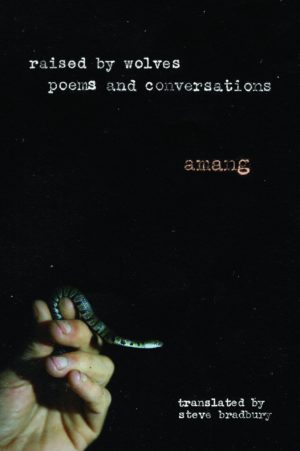Raised by Wolves
by Amang, translated by Steve Bradbury
reviewed by Zack Anderson
Translated books always offer a tacit invitation to think through power dynamics, raising questions of ownership and authorship, linguistic mastery, race and gender, false binaries of “original” and “copy,” and so on. Often, these questions hover in the background, but Raised by Wolves: Poems and Conversations, winner of the PEN Award for Poetry in Translation, confronts them explicitly at every turn. A hybrid text comprising poems by Taiwanese poet and filmmaker Amang along with recorded conversations between Amang and her American translator Steve Bradbury, Raised by Wolves celebrates translation as an ongoing dialogue, one that does not offer authoritative answers but rather provokes endless questions.
In presenting translation as dialectical, Raised by Wolves foregrounds the power struggles that are typically camouflaged by the conventional presentation of a translated text. Amang and Bradbury allow these tensions to sit on the surface of these pages, forcing the reader to join their productive discomfort. For instance, one of the conversations takes a truly Hegelian turn when Amang teasingly declares, “Yes, you are my slave and I am your master, so no more talk of rewriting my work or I will cut out your tongue.” In another scene, Amang notices Bradbury’s equipment and remarks, “What are you doing? Are you recording our conversations?!?” Bradbury replies, “How else am I going to remember all the stuff you tell me about your poems? And all the complaints you have about my translations?”
While conversations like these depict the author-translator relationship as playfully adversarial, the book opens up these power struggles by allowing the translations to take shape across multiple versions. The best example of this appears in the pair of poems titled “Her Fingers Kept Tensing” and “My Fingers Tense and Relax, Tense and Relax,” which depict themes of illness, caretaking, and loss of control. The first version describes an unnamed cancer patient, later revealed to be an old friend of Amang’s:
Her Fingers Kept Tensing
as she works the pink rubber ball in her palm
laboriously breathing
resistance on the one hand helps her on the other
recover
that “grip” she had of old
In this version, the title’s focus on the woman’s fingers gives them their own sense of agency, as she struggles to “recover / that ‘grip’ she had of old.” The conversation provided between versions reveals that the poem is actually only a part of a larger poem of which the first page has gone missing. Responding to Bradbury’s first version, Amang insists on the phrase “tenses and relaxes,” explaining that “I want the reader to see tension and relaxation in a dynamic balance, like breathing in and breathing out, yang and yin, death and life. Both are critical, equally dependent.” As Amang explains her intention in the Chinese poem, it feels like she could be describing a general approach to translation, where multiple versions “breathe” reciprocally in a sequence that could go on forever.
Bradbury’s second version, “My Fingers Tense and Relax, Tense and Relax,” accommodates the critical reading in the dialogue between author and translator. After Amang points out that Bradbury “must have lost a page” in the first version, he recovers the lost stanzas, which widen the frame of the poem and place the emphasis on the speaker rather than the patient:
My fingers tense and relax, tense and relax
I haven’t a clue what they are up toI’d seen the invalid home
bearing the wounds where she had come under the knife
hands
she hardly knew
opening a door with no warning signs
sink into the sofa
her fingers tense and relax, tense and relaxas she works the pink rubber ball in her palm
belly breathing
resistance on the one hand helps her on the other
recover
that “grip” she had of old
However, despite the richness of these two versions and the paratextual commentary in between, Amang and Bradbury cannot quite give themselves over to multiplicity. The book may make room for multiple versions, but it always eventually compares them qualitatively. At the end of the second version, Amang remarks, “Yes, this version is much better, Steve. I don’t know why you didn’t make it like this at first. It would save us a lot of time.” Sometimes, the collaborators’ commentary on translation seems at odds with the book’s ethos. For instance, both Amang and Bradbury affirm an economic model of translation that seeks foremost to balance “losses” and “gains.” “My version has more oomph, more buck for the dollar,” says Bradbury in one conversation. At another point, Amang praises him in the same vein: “Good! You compensate here where you lose something there—I like that strategy.”
As frustrating as they can be, the contradictions registered by Amang and Bradbury are valuable because of their visibility. The reader is invited to engage directly with the thorny questions of power, authorship, and originality through these poems and conversations. Most importantly, Raised by Wolves models reading—and translation itself—as a multidirectional practice. Amang and Bradbury remind us that there is no final, authoritative version, but a conversation that extends far beyond the boundaries of the book.
Published on April 19, 2021

